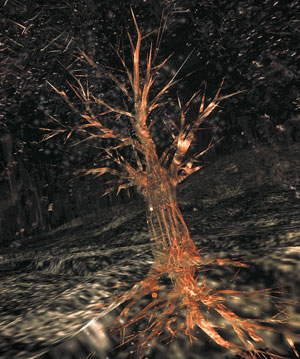We live in a peculiar world. We are peculiar beings. The knowledge of our world, of ourselves, has made huge progress since the beginning of time. Human beings are like that. This world, our world is especially sensible to its perceptions. We construct our physical life with the conception we have of our visual environment, sonorous, of touch, of odours, of taste. Its sensations, the perception we have of it, construct our universe of life.
The progress of science in the twentieth century made us discover that the field of perception of our senses is limited and essentialy perceptive. For example, the human eye can pick up colours (which are in fact waves, a specifc kind of electromagnetic energy)between 400 and 700 microns, 400 being violet and 700 red. The phenomenum is similar for sound waves, etc. Therefore we evolve in a certain relativity because if our visual perception is limited at 400 to 700 microns, this does not mean that other colours that our eye ignores do not exist, sounds that our ear cannot perceive. We can put forward that our state of being, our nature, is linked in part, to our perceptive universe. The rest is linked to the laws inherent to the nature of the world in which we evolve; for example, the oceanic space, the outer space, the terrestrial space . . . are all spaces that respond to distinct laws.

Charlotte Davies with Georges Mauro in the projection room of the Montreal Museum of Contemporary Art.
photographed by Jean-Frangois Lenoir for Parcours L'lnfomateur des arts © Jean-Franqois Lenoir 1995.
This introduction on our state of being is primary for a better comprehension of the work of Charlotte Davies. Charlotte Davies is a multidisciplinary artist, who had painted until she discovered the world of creation in three dimensions, computer assisted. And then she discovers what a lot of people call "virtual reality". A term that does not mean much now. Charlotte Davies prefers "immersive virtual space". Davies is part of the first wave of the Softimage company, whose 3D animation technology provided world-wide recognition. Its technology is used in many felds, especialy for the animation of the dinosaurs in the film «Jurrasic Park». This technology, developed by Softimage, is mostly dedicated to commercial purposes. Charlotte Davies uses for artistic exploration all the technological and logistical resources of Softimage (where she is director of Visual Research). She brings this technology to astonishing frontiers that make us question our perceptive universe, our future and our real identity: Who are we? Where do we come from? From where do we go?
Osmose
Osmose is a new kind of art work, created and directed by Char Davies with the help of Georges Mauro for the graphics, John Harrison for the virtual reality software, Rick Bidlack for the music and Dorota Blaszczak for the design and sound programming. Osmose defines itself as a particular work claiming for computer assisted creation, the status of major medium of expression.
From August 19th to October lst, the visitors of the Musée d'Art Contemporain de Montreal could see Osmose. People were entering in a very dark room (nescessary for the visualisation of the screen) were there was a large video screen. At the entrance, each of the visitors were given a pair of glasses, nescessary to perceive the third dimension. Then the adventure unfolds before our eyes. From the screen were emerging shapes more or less precise where we recognized an imaginary landscape, synthetic. We traveled through in an timeless and immaterial manner, landscapes that could as well be interior. Behind the visitors of the exhibit, we could discem an opaque screen where a silhouette was moving, a body we guess with a strangely cabled head. This is the real Osmose adventure.
Some privileged visitors could wear an immersive helmet and hook their breathing to Osmose. What the other spectators see on the screen is in fact what the helmet wearer lives. He/She travels in Osmose with his/her movements and with his/her breathing. Art initiatic trip inside oneself. The holder of the helmet enters in a new nature, in new rules, in new laws. Osmose offers to the wearer of the helmet a perceptivity and sensitivity incomparable with other types of art mediums. It opens a universe even more vast and more rich than the one we are perceiving now and leads us we know not where.
This article may include minor changes from the original publication in order to improve legibility and layout consistency within the Immersence Website. † Significant changes from the original text have been indicated in red square brackets.

